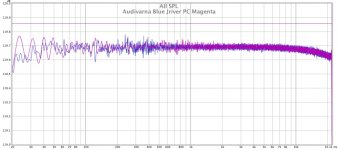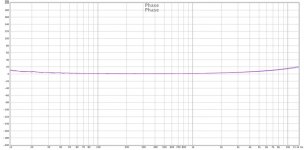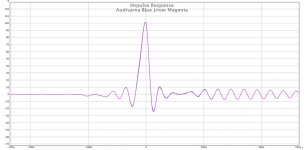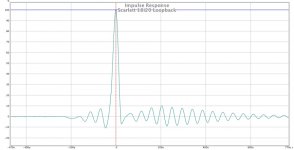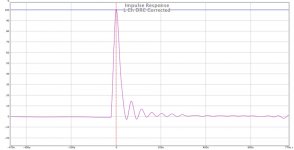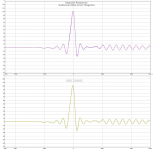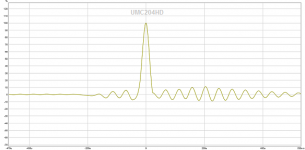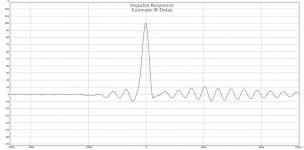Even feeding it a simple IR would work. The recorded IR on the other end could be imported into REW.Audivarna doesn't have input capability so it would need to be a file played back on both to be a fair comparison. Maybe an REW sweep output to WAV and recorded into Audacity might work? If you can think of a better way let me know and I will try it.
I would be very surprised to see any difference but it's always good to check
I did a test by playing a Dirac Pulse at 44.1K in both Audivarna on Mac and Jriver on PC and recording the output in Audacity by loopback cable.
There are some very slight differences but I think that can be put down to test variability and the fact that recording an impulse like this is not as clean as doing a pure loopback in REW.
SPL Frequency Response zoomed in note the scale of 0.1dB
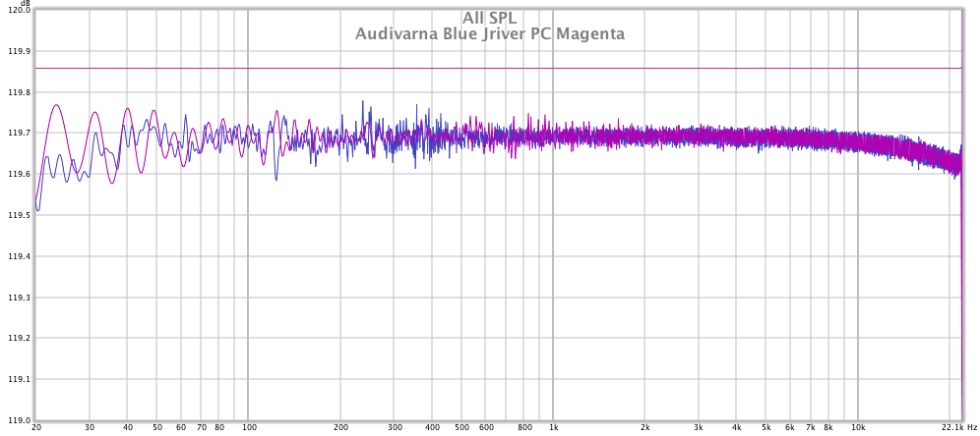
Phase
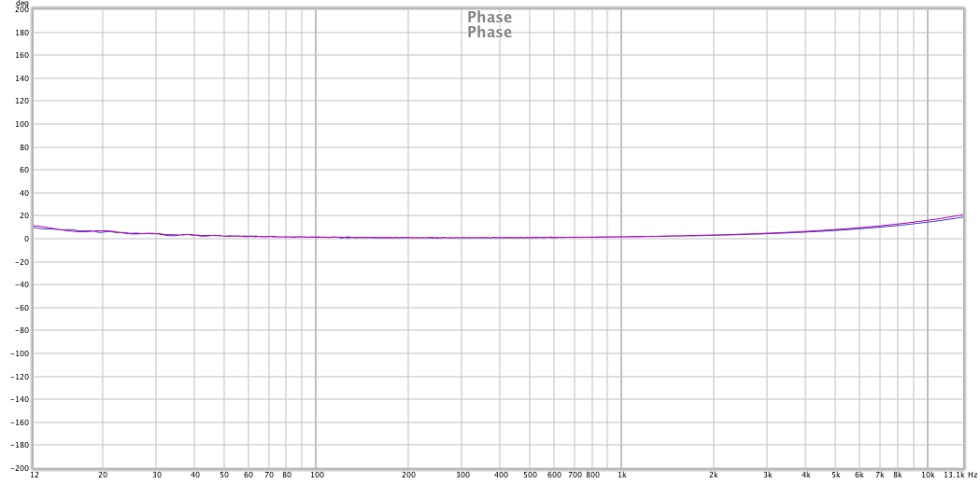
Impulse, I did my best to line them up but there is still a very slight difference that is hard to overcome when recorded on two different systems. The overall shape is due to the ADC and DAC filters of the Focusrite.
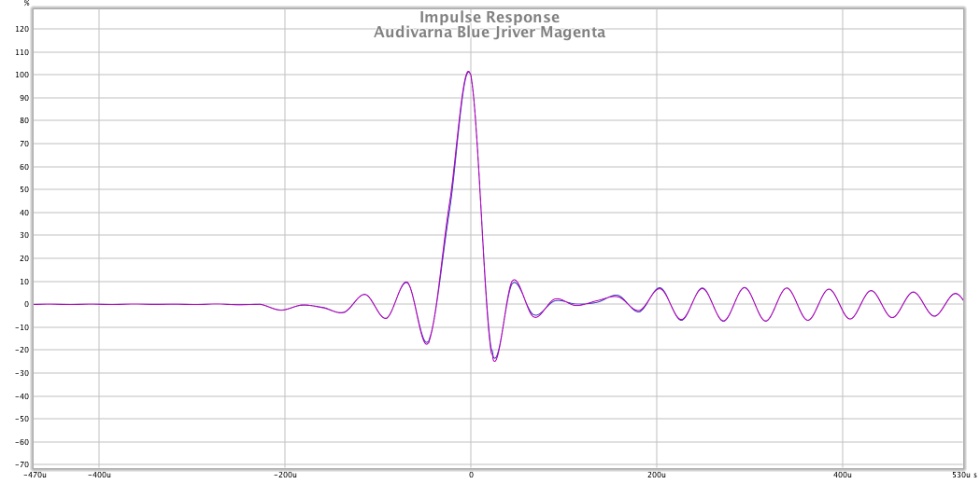
I don't see anything that would make them sound different so if they do then it might be time to start checking the settings or digging deeper to find what is going on.
There are some very slight differences but I think that can be put down to test variability and the fact that recording an impulse like this is not as clean as doing a pure loopback in REW.
SPL Frequency Response zoomed in note the scale of 0.1dB
Phase
Impulse, I did my best to line them up but there is still a very slight difference that is hard to overcome when recorded on two different systems. The overall shape is due to the ADC and DAC filters of the Focusrite.
I don't see anything that would make them sound different so if they do then it might be time to start checking the settings or digging deeper to find what is going on.
Attachments
Interesting test, thanks. Have you ever heard differences between the two when playing music like Perceval observed?
And could you run a sweep in REW trough the JRiver chain? That would give more data to look at. For a DAC to have 10% swings after the main peak I always wonder why. It's probably high frequency filters we are looking at around 22 KHz, but that should show up in an early waterfall plot.
I realize we are looking at a zoom of half a millisecond. But these are the things we change within Windows with our timing tweaks. I had always heard a difference between Wasapi and Asio within my own system. Untill I tweaked the Asio buffers to get both measured IR sweeps more similar in loopback tests. I needed the Asio driver as using Wasapi would not give me the surround channels. For the longest time I was using Wasapi because it sounded superior.
I'll never make the mistake again thinking that there are no differences to be observed, though in your plots I'd doubt we could hear any. They are real close, even the IR.
I'd be real interested in a similar comparison from perceval's system.
And could you run a sweep in REW trough the JRiver chain? That would give more data to look at. For a DAC to have 10% swings after the main peak I always wonder why. It's probably high frequency filters we are looking at around 22 KHz, but that should show up in an early waterfall plot.
I realize we are looking at a zoom of half a millisecond. But these are the things we change within Windows with our timing tweaks. I had always heard a difference between Wasapi and Asio within my own system. Untill I tweaked the Asio buffers to get both measured IR sweeps more similar in loopback tests. I needed the Asio driver as using Wasapi would not give me the surround channels. For the longest time I was using Wasapi because it sounded superior.
I'll never make the mistake again thinking that there are no differences to be observed, though in your plots I'd doubt we could hear any. They are real close, even the IR.
I'd be real interested in a similar comparison from perceval's system.
I can't say I have noticed a difference between them but I have not done a side by side test, with all the processing involved in the chain now it would be a bit of effort to get Audivarna to the same point.
This is a loopback impulse from REW without Jriver involved and it is definitely the reconstruction filters that are causing the ringing.
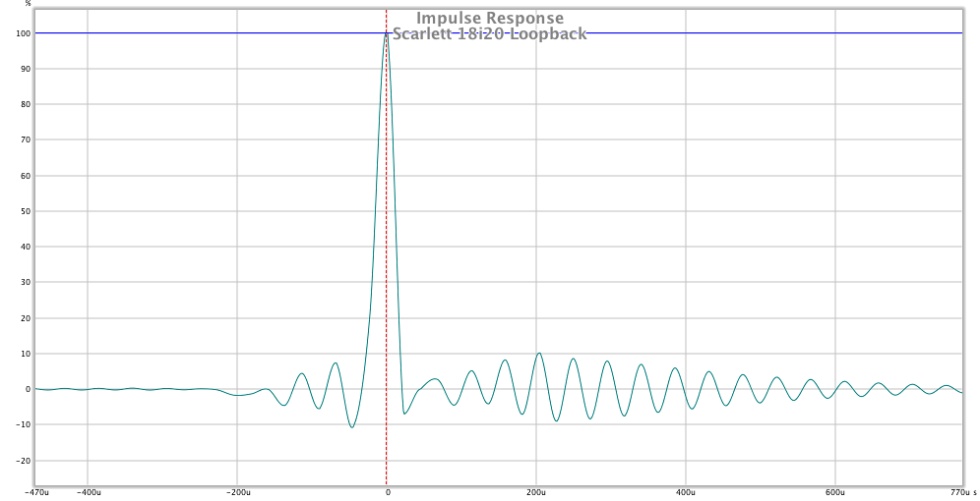
What's interesting is this is my Left Channel corrected impulse when run through DRC
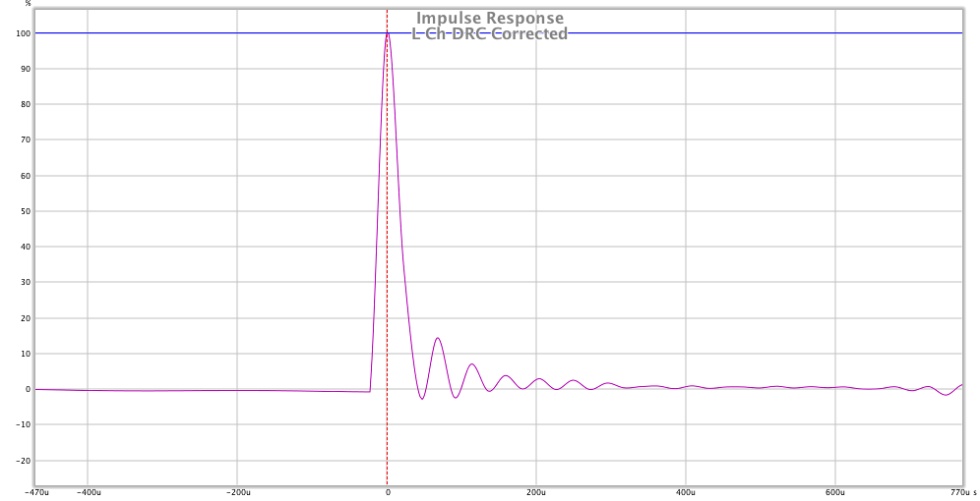
This is a loopback impulse from REW without Jriver involved and it is definitely the reconstruction filters that are causing the ringing.
What's interesting is this is my Left Channel corrected impulse when run through DRC
Attachments
I'd be real interested in a similar comparison from perceval's system.
I will, as soon as I find the time and get some quiet time at the house!
...For a DAC to have 10% swings after the main peak I always wonder why. It's probably high frequency filters we are looking at around 22 KHz, but that should show up in an early waterfall plot...
Agree the wondering for those swings and some guesses would be they cut development cost not implement filters by the book and as silicon manufacture suggest implemented, or it is by purpose so as their more expensive products perform better than this mess, or also it can be to have their own sound signature to stick out from other products.
By the way i have Behringer UMC204HD and a loop back at 44,1kHz against fluid's Scarlett 18i20, can anybody tell the difference : )
Aligned with "Estimate IR delay":
Attachments
Those filters are the digital ones baked into the ADC and DAC chips. Behringer and Focusrite have used the same chip by the look of the signature. I don't think it is cost cutting in the implementation more in the chip itself. I have got a couple of DAC's with selectable filters and the differences are quite subtle even when the impulse looks completely different.Agree the wondering for those swings and some guesses would be they cut development cost not implement filters by the book and as silicon manufacture suggest implemented
Not meBy the way i have Behringer UMC204HD and a loop back at 44,1kHz against fluid's Scarlett 18i20, can anybody tell the difference : )
I always wonder what is the correct point for the impulse to be aligned to as the estimate function can be a bit unreliable and it makes a huge difference to the look of the IR by removing/changing the time delay.Aligned with "Estimate IR delay":
No problem same to youThanks doing the work and share data fluid : )
One other thing I should mention is that a different volume levelling is used in some of the programs and this can result in slightly different playback levels between applications. This can really change the way it sounds on an AB comparison. I was testing Audivarna against itunes and it did sound different, I checked the relative volume offsets and they were different by about 1dB. Once I turned it off I really couldn't tell the difference between the two programs.
Some things are subtle at best, other things stand out more.
Not all of them are easy to measure. I know my specific example of Wasapi vs Asio had nothing to do with SPL level.
Before getting a dedicated DAC for my arrays I ran from the Asus Xonar Essence ST card. I was very pleased with it, but it always had a faint (power supply) hum. Inserting a ground loop isolator helped.
When I switched to the dedicated DAC I had to work hard to get to the same level of performance. I tried USB at first, later went to optical and that solved the hum. Though I had to play extensively with settings to get the same or similar sound as I had with the Asus directly. Wasapi was the first answer I settled on but I'm glad I could measure my way to a similar experience with the Asio drivers.
Usually when something plays louder it becomes more attractive as a sound experience. When the buffer settings are wrong this is not the case.
Tonally I can't find or lock down the fault, though I know something is wrong if I can't enjoy long sessions without getting tired from it.
Remember a few pages back I was disappointed in my average based corrections? Part of that will be linked to a 5th element (lol) where I thought there were 4 things I did different. I should give it another shot.
Factor no. 5 being the buffer problem I fixed recently. (Patched up, really, I still need to do my share of loopback tests to realign everything. I need to move back to SSD OS hard-disk first)
It will be interesting to learn if we can find differences within perceval's 2 setups. It seems his problems are easier to hear/observe.
I really do think everything matters. To what degree is another discussion.
As Fluid showed, DRC will fix (some of) the IR if the DAC is off a bit. However a buffer problem causes intermittent problems in flow of the stream. Having it set too small will even cause clicks or pops.
Not all of them are easy to measure. I know my specific example of Wasapi vs Asio had nothing to do with SPL level.
Before getting a dedicated DAC for my arrays I ran from the Asus Xonar Essence ST card. I was very pleased with it, but it always had a faint (power supply) hum. Inserting a ground loop isolator helped.
When I switched to the dedicated DAC I had to work hard to get to the same level of performance. I tried USB at first, later went to optical and that solved the hum. Though I had to play extensively with settings to get the same or similar sound as I had with the Asus directly. Wasapi was the first answer I settled on but I'm glad I could measure my way to a similar experience with the Asio drivers.
Usually when something plays louder it becomes more attractive as a sound experience. When the buffer settings are wrong this is not the case.
Tonally I can't find or lock down the fault, though I know something is wrong if I can't enjoy long sessions without getting tired from it.
Remember a few pages back I was disappointed in my average based corrections? Part of that will be linked to a 5th element (lol) where I thought there were 4 things I did different. I should give it another shot.
Factor no. 5 being the buffer problem I fixed recently. (Patched up, really, I still need to do my share of loopback tests to realign everything. I need to move back to SSD OS hard-disk first)
It will be interesting to learn if we can find differences within perceval's 2 setups. It seems his problems are easier to hear/observe.
I really do think everything matters. To what degree is another discussion.
As Fluid showed, DRC will fix (some of) the IR if the DAC is off a bit. However a buffer problem causes intermittent problems in flow of the stream. Having it set too small will even cause clicks or pops.
My comment was aimed at AB testing programs rather than specific settings, sometimes the programs make it hard to get an accurate baseline.I know my specific example of Wasapi vs Asio had nothing to do with SPL level.
That is very true, I have been listening with my LKS ES9018 DAC for a few days now and it is not sounding quite as good as the Focusrite interface. I am wondering if that is partly because the correction is based on measurements with the Focusrite in the chain and it's oddities have been taken into consideration.I really do think everything matters. To what degree is another discussion. As Fluid showed, DRC will fix (some of) the IR if the DAC is off a bit.
I know you were aiming towards the programs with the SPL comment. 
I just wanted to be more specific about this driver and DAC stuff etc. Basically noting that it wasn't smooth sailing from the start.
Each time I had to work on it to find the right or most pleasing settings.
Even though I think I should give averaging a second chance. However I did notice my old FIR correction worked better at low frequencies. I had done a few tricks to that using RePhase and those worked out well. (the redistribution of bass energy between left and right speaker)
I just wanted to be more specific about this driver and DAC stuff etc. Basically noting that it wasn't smooth sailing from the start.
Each time I had to work on it to find the right or most pleasing settings.
Even though I think I should give averaging a second chance. However I did notice my old FIR correction worked better at low frequencies. I had done a few tricks to that using RePhase and those worked out well. (the redistribution of bass energy between left and right speaker)
(Patched up, really, I still need to do my share of loopback tests to realign everything. I need to move back to SSD OS hard-disk first)
First part is done, back on SSD. Samsung's Data Migration is an awesome tool. At least for those with Samsung SSD's.
Indeed, very nice tool. Added a Samsung 1T SSD to my laptop 2 months ago. Has dual bays so just add and migrate.First part is done, back on SSD. Samsung's Data Migration is an awesome tool. At least for those with Samsung SSD's.
Yes, I've seen worse. I've done many of these transitions on demand and always had to revert to all kinds of (usually free) tools to get the job done. This is a tool that hasn't let me down yet. Making it a breeze to migrate the OS and other parts.
I had a 1TB ordinary drive with pre-installed (Win 7 Pro) OS, belonging to this workstation that I now use as the OS. I still ran my retail Win 7 Pro before the hick-up and had to back-up some data off of a partition on my dual SSD's that ran in Stripe configuration.
I'm currently reconsidering if I go back to mirror with the OS. As I now have a back-up NAS I might skip that part. I've been running dual OS disks in (software) Raid mirror for more than 10 years, going back to a once hacked Win XP long ago to be able to run that. With some server files added to XP it could run in Software Raid Mirror.
I might do it different this time though. Keep my DATA in mirror + backup and leave the OS on a single SSD (also back-upped obviously).
I had a 1TB ordinary drive with pre-installed (Win 7 Pro) OS, belonging to this workstation that I now use as the OS. I still ran my retail Win 7 Pro before the hick-up and had to back-up some data off of a partition on my dual SSD's that ran in Stripe configuration.
I'm currently reconsidering if I go back to mirror with the OS. As I now have a back-up NAS I might skip that part. I've been running dual OS disks in (software) Raid mirror for more than 10 years, going back to a once hacked Win XP long ago to be able to run that. With some server files added to XP it could run in Software Raid Mirror.
I might do it different this time though. Keep my DATA in mirror + backup and leave the OS on a single SSD (also back-upped obviously).
Last edited:
I stopped worrying about this a while ago. Installing Win7 or newer from USB to an SSD is quite quick. Recovering a backup image should be, too.I'm currently reconsidering if I go back to mirror with the OS.
Of all the possible issues that can bring down a PC, mirroring the OS disk covers only one. Which is a big part of why we keep backups on other devices, of course. But with 1 spare drive available, I'd rather clone the OS monthly and keep the spare disconnected.
Exactly what I was thinking. And the primary reason of not running the OS in mirror anymore.
It was a neat trick in the past, before SSD drives. As with software raid and 2 disks I mirrored the OS and made a temporary drive for the OS on a stripe partition. A measurable gain in performance compared to running the OS on a single drive or in raid mirror only.
Raid mirror is somewhat slower (not much) in writing, so every temp file or swap file was directed to the faster stripe partition.
It was a neat trick in the past, before SSD drives. As with software raid and 2 disks I mirrored the OS and made a temporary drive for the OS on a stripe partition. A measurable gain in performance compared to running the OS on a single drive or in raid mirror only.
Raid mirror is somewhat slower (not much) in writing, so every temp file or swap file was directed to the faster stripe partition.
Last edited:
- Home
- Loudspeakers
- Full Range
- The making of: The Two Towers (a 25 driver Full Range line array)
